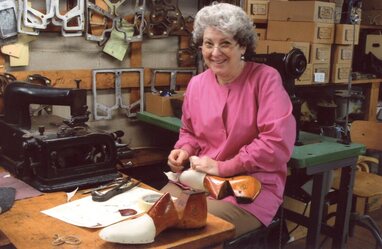 Randy Kroop is a fourth-generation shoe and boot maker. Her family name is synonymous with high quality leather boots. As a teenager, Randy’s grandfather, Adolph Michael Kroop, known as “Mitch,” emigrated from Latvia, Northern Europe and made his way to Baltimore, Maryland; where he opened his first shop, near Pimlico Park, in 1907. He later moved to set up shop on Main Street in Ellicott City, across from Kaplan's Department Store and in 1927 he took occupancy in a building on Laurel’s Main Street. By the 1960’s he expanded and relocated operations to the leather factory building, A.M. Kroop and Sons, on C Street. Being located near Laurel Park, Kroop specialized in riding boots for jockeys, who required very sturdy yet lightweight boots in sizes much smaller than the typical man’s shoe. Kroop boots, using the tagline “often imitated, never duplicated,” were worn by famous jockeys and celebrities. Mitch Kroop made boots for Red Pollard, the jockey who rode Seabiscuit to fame in the late 1930s. In 2003, when the movie Seabiscuit was made, Randy made the reproduction boots for the actors. She also made riding boots and jockey boots for the movie Secretariat, released in 2010. Carly Simon, Madonna, and Leon Redbone are also included in their customer roster. From the beginning, A.M. Kroop and Sons was a family business. Having learned to cobble from his father, A.M. Kroop taught his sons the trade, while his daughter helped with bookkeeping. Randy recalls childhood days spent at the factory, and when the jockeys came into the shop in the mornings since they rode in the afternoons. Randy was very skilled in sewing and made many of her own clothes growing up, often because they did not have the means to buy the pretty clothes the girls in her school wore. But this talent, work ethic, and hands-on attitude were a perfect fit when it came time for the next generation to take over the family business. At the time, the horse racing industry was changing, and Randy soon specialized in helping people with problem feet or those wearing braces to have custom shoes that actually fit. She remembers these experiences as very rewarding. She inherited ten employees who had worked with her grandfather and/or her father. Many of them had watched her grow up from a little girl, which added to the challenge of being their new manager. Her given name worked to her advantage in many cases, as people assumed the owner was a male, or that she was one of the “sons” in the business. However, the work was very difficult and labor intensive, involving many steps in the boot-making process. The machines were big and heavy, and required a lot of training. Randy took on new employees over the years. However, she operated alone by the time of her retirement in 2019. She still keeps in touch with some of the grandchildren of those employees, fondling recalling the time a former employee - the first female hired by her grandfather- chose for her 80th birthday present to return to Laurel (from Delaware!) and visit the factory one more time. Randy remembers her walking right over to her old sewing machine. The woman was French-Canadian, and Randy remembers that her father and grandfather often hired refugees or immigrants, including other Jewish families. Although the Kroops lived in Baltimore, they were one of about only five Jewish families working in Laurel, at the time. Randy recalls other changes to the industry. When she started, Randy remembered when jockey boots were wearing size 2 or 3 boots; the famous jockey Willie Shoemaker had a size 1 last. But toward the end of her career, it was common to make bigger boots for jockeys who were 5’7” or so in height. Randy also specialized in riding boots for motorcycle police, indicating that one pair she made had a boot shaft of 21 inches around! Although she did not grow up in Laurel, Randy spent many days of her childhood in the family factory. She remembers when Laurel had a reputation for being “shady” and remembers that her father kept the children away from the racetrack. It wasn’t until she took her dogs out for walks along Riverfront Trail that she started to get to know the history of Laurel. She remembers long walks and conversations with Jim McCeney and Jim Frazier, who pointed out historic buildings and places of interest. Today, Randy Kroop is keeping busy in retirement and misses her old family shop. She has donated many items to the Laurel Historical Society, adding to our history and knowledge of a family business that has celebrated being in business ‘for upward of a century.” Information and photograph pulled from LHS collection files and oral interview with Randy Kroop, 2021. Click here for the PDF version of this article.
Mary
9/5/2021 05:12:13 pm
I grew up in Maryland. Wish I had known about your shop. Would have loved getting a pair of riding boots from your establishment. Enjoy your retirement. Comments are closed.
|
AuthorContributions by Laurel Historical Society staff and volunteers. Submissions welcome! Archives
August 2022
Categories |
LAUREL HISTORICAL SOCIETY
History & Happenings Blog
Home
|
Site Map |
Laurel Historical Society
817 Main Street Laurel, MD 20707 301-725-7975 [email protected] Laurel Museum Hours: Friday - Sunday 12-4 pm Research and Tour groups by appointment. |
© COPYRIGHT 2015-2023. ALL RIGHTS RESERVED.
 RSS Feed
RSS Feed

